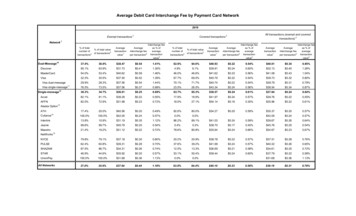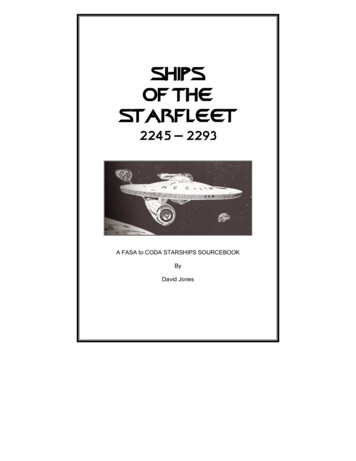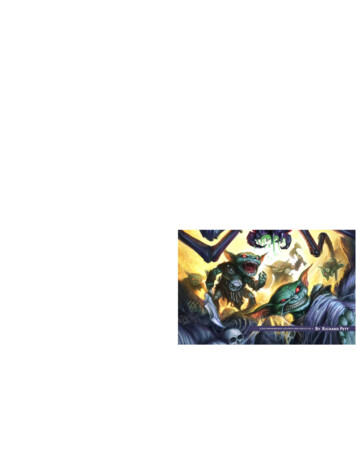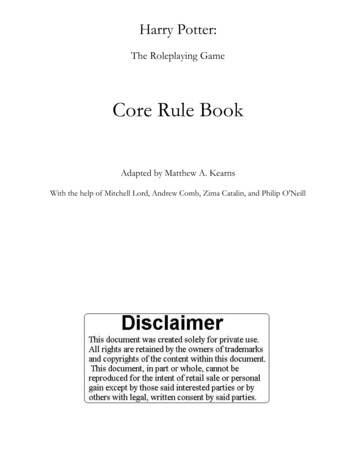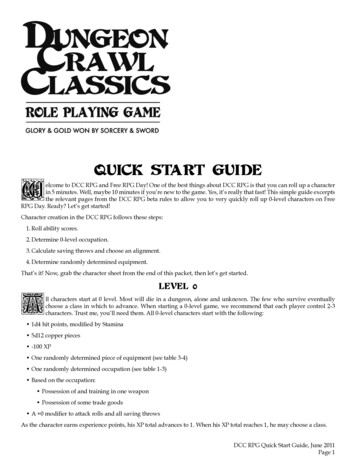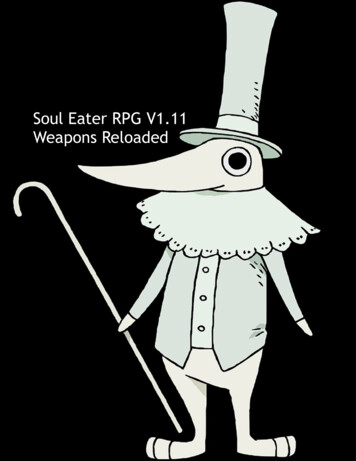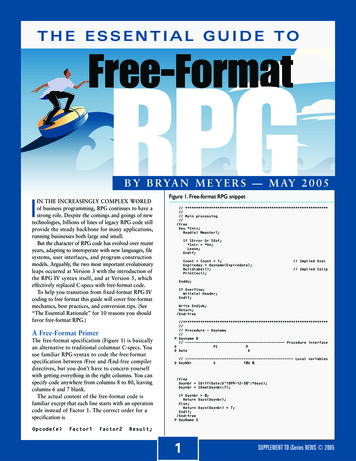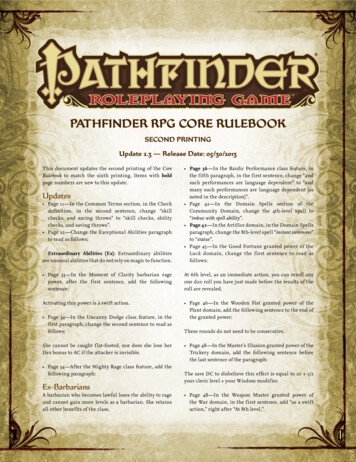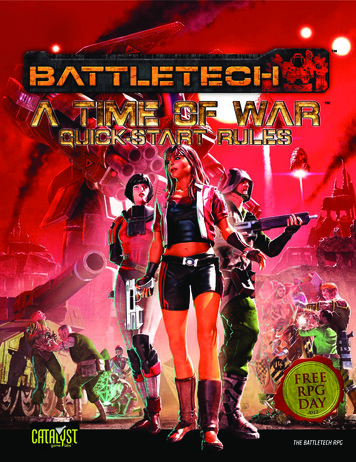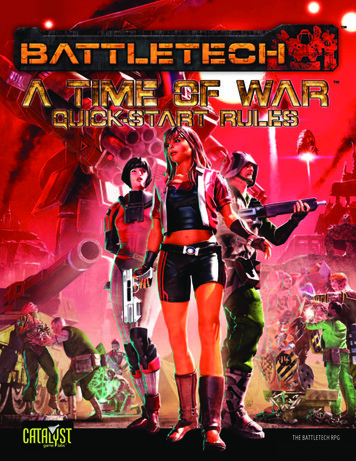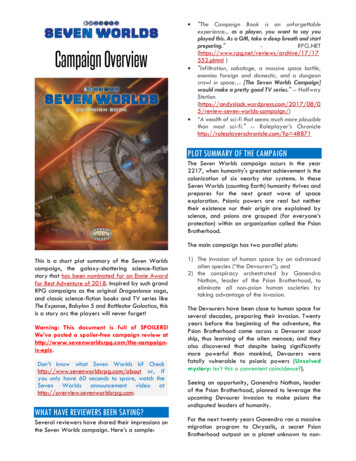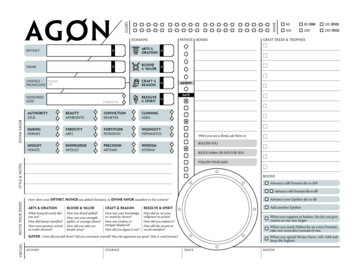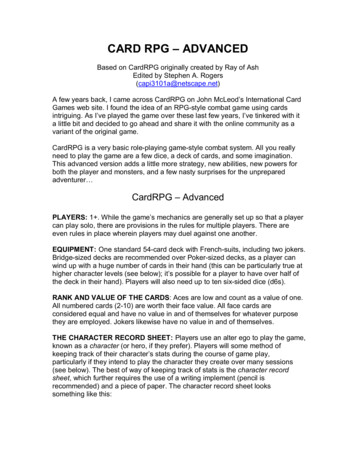
Transcription
CARD RPG – ADVANCEDBased on CardRPG originally created by Ray of AshEdited by Stephen A. Rogers(capi3101a@netscape.net)A few years back, I came across CardRPG on John McLeod’s International CardGames web site. I found the idea of an RPG style combat game using cardsintriguing. As I’ve played the game over these last few years, I’ve tinkered with ita little bit and decided to go ahead and share it with the online community as avariant of the original game.CardRPG is a very basic role playing game style combat system. All you reallyneed to play the game are a few dice, a deck of cards, and some imagination.This advanced version adds a little more strategy, new abilities, new powers forboth the player and monsters, and a few nasty surprises for the unpreparedadventurer CardRPG – AdvancedPLAYERS: 1 . While the game’s mechanics are generally set up so that a playercan play solo, there are provisions in the rules for multiple players. There areeven rules in place wherein players may duel against one another.EQUIPMENT: One standard 54 card deck with French suits, including two jokers.Bridge sized decks are recommended over Poker sized decks, as a player canwind up with a huge number of cards in their hand (this can be particularly true athigher character levels (see below); it’s possible for a player to have over half ofthe deck in their hand). Players will also need up to ten six sided dice (d6s).RANK AND VALUE OF THE CARDS: Aces are low and count as a value of one.All numbered cards (2 10) are worth their face value. All face cards areconsidered equal and have no value in and of themselves for whatever purposethey are employed. Jokers likewise have no value in and of themselves.THE CHARACTER RECORD SHEET: Players use an alter ego to play the game,known as a character (or hero, if they prefer). Players will some method ofkeeping track of their character’s stats during the course of game play,particularly if they intend to play the character they create over many sessions(see below). The best of way of keeping track of stats is the character recordsheet, which further requires the use of a writing implement (pencil isrecommended) and a piece of paper. The character record sheet lookssomething like this:
s:HP:Jokers:Sessions:Here’s a quick explanation of what this means:· Level: This measures the character’s level, i.e. how far they’ve advanced.Level has a bearing on how tough your opponents are and the maximumnumber of attacks they receive.· Character: This is the character’s name. Strictly speaking, this isn’t a vitalstat, but it does add to the game’s flavor.· Class: This is the class of the character, which is basically just the cardthe player chooses to represent their character (see below). A character’sclass determines what kinds of abilities they have access to during thegame.· STR: This is the character’s strength. Strength directly determines the sizeof the character’s hand, which in turn determines how much damage theplayer can cause at any one time (see below).· HP: The character’s hit points. This is how much damage the player’scharacter can sustain in any one fight before they die. Death has nothingbut negative effects, so a high HP is a Good Thing.· XP/Next: This lists the character’s accumulated experience points and theamount they need to get before reaching the next level. All monsters (seebelow) are worth some experience points when defeated; some more sothan others.· Gold: This lists the total amount of gold the character has on hand. Goldcan be used at any time to buy back cards from the discard pile (seebelow) or to buy items into inventory. Characters receive gold only undercertain circumstances.· Jokers: This lists the total number of jokers the character has killed incombat. Jokers are vicious as opponents; defeating one is worth a badgeof honor · Kills: This lists the total number of monsters the character has defeated.· Deaths: This lists the total number of times the character has beendefeated.· Sessions: This lists the total number of times the player has “ran through”the deck (i.e. gotten to the point where there aren’t enough active cardsleft to complete an action). Players can also end the game voluntarily. It’sbasically a measure of how often the character has been played.CREATING A CHARACTER: When a player is playing the game for the first time,they will need to create a character in order to play the game. The first thing theplayer should do is go ahead and name their character. This name can beanything the player deems suitable for the game. Next, on the character recordsheet, they can record “1” for the level, 0/10 for their XP, and 0 for Gold, Jokers,Kills, Deaths and Sessions. The sheet will look something like this at this point:
Level: 1Class:XP/Next: 0 / 10Kills: 0Character: CapiSTR:Gold: 0Deaths: 0HP:Jokers: 0Sessions: 0The next thing the player will need to do is roll for their character’s Strength andHP. Each one of these is handled by a separate dice roll. Begin with Strength.Roll the dice, divide the result by two, round up, and add two to the result. Thefinal value is the character’s Strength, which is recorded in the STR box (forexample, if the dice roll for strength were a five, you would divide that by twogetting two point five, round up getting three, and add two getting a final strengthof five). Now roll for the character’s HP. Add two to the result of the dice roll andrecord the final amount in the HP box (a roll of five for HP would end up as a finalresult of seven HP).The last and most crucial decision to be made is the character’s Class. Theplayer may sift through the deck to find a face card of their choice to representtheir character. Their choice must be a bonafide face card; they may not pick aJoker or number card. Each face card has a different array of special abilities, asoutlined below:· Jacks are thrifty characters. When they claim items into their inventory,they always receive an extra card. Jacks can be robbed (see below) byboth Queens and Kings.· Queens are knowledgeable characters. They can be robbed by Kings. Ifthey are killed, they retain their XP.· Kings are powerful characters. They can be robbed by Queens. If they arekilled, the player has the option to keep their hand.Additionally, all face cards are allowed to use any card in their inventory as acard of the character’s suit (i.e. a Spade character can use any card as a Spade,Club characters as Clubs, etc.; see Inventory, below).INVENTORY: During the course of gameplay, characters may gain extra cardsthat can be used in order to expand upon the character’s abilities. Collectively,these cards are called the player’s Inventory. Inventory cards are alwaysnumbered cards. What each card can do depends upon the value of the card andits suit, as follows:· Spades: These are attack cards. A player may choose to play a Spadebefore making their normal attack for the turn, scoring an amount ofdamage equal to the value of the card. The player’s regular attack for thatturn does not need to match the value of the Spade, but if it does, theSpade does not count towards a combo (see below).· Hearts: These are life cards. Ordinarily, when a character’s HP falls belowzero, they die. However, if the character is carrying around a heart, theystay alive, with the number of HP equal to the value of the card.
Diamonds: Diamonds represent gold. When a diamond enters theplayer’s inventory, the diamond card is placed on the bottom of the drawpile and the character gains an amount of gold equal to the value of thecard. Gold can be used for one of two purposes: it can be used to buycards back from the discard pile at a cost of one gold per card, or it can beused to buy the top card off of the top of the draw pile into the player’sInventory, at a cost equal to the value of that card (Aces cost 20 to buy;this is the only exception). If the player can’t buy the card, chooses not tobuy the card or can’t afford it, that card is discarded.· Clubs: These cards allow a multi attack. The player may make one extraattack on their turn for every Club expended (note that the value of theClub doesn’t matter; the player only gets to make one extra attack). In thiscase, the value of the attack cards play doesn’t have to match, as with aregular combo.Characters may always play inventory cards as though the card were of the suitthat matches the character’s suit (e.g. a Spade character can play any inventorycard as though it were a Spade). Diamond characters always have the option of“selling off” their Inventory cards, in which case they merely discard the card andpocket the gold.·A player may play a card out of their inventory at any time they wish. Onceplayed, an inventory card goes into the discard pile.ACE POWERS: Aces are treated as special cards when they wind up in aplayer’s Inventory. All aces have very powerful effects, as follows:· Ace of Spades: The Ace of Spades is an auto kill. When used, itautomatically kills the monster being fought against (quite handy against aJoker at high levels).· Ace of Hearts: The Ace of Hearts is a super life potion. If the player dieswhile holding the Ace of Hearts, they are restored to full HP immediately.The Ace of Hearts is the only way to survive a monster’s Joker attack card.· Ace of Diamonds: The Ace of Diamonds is a luck gem. It can be used tobuy cards back from the discard pile (it cannot, however, be used to buycards into Inventory). This Ace is special in that it cannot be expended,even if the player dies; the only way to lose the Ace of Diamonds once it isin Inventory is to have it stolen away.· Ace of Clubs: The Ace of Clubs is a blitz attack. It can be used to allow aplayer to unload any card or combo from the players hand, even allowingthe player to unload their entire hand on a monster all at once.With the sole exception of the Ace of Diamonds, an Ace is expended once used.Unlike normal Inventory cards, an Ace is returned to the bottom of the draw pile ifthe player uses it.SETUP: At the beginning of each session, the player goes into the deck andlocates the card matching their character’s class. They pull that card out of thedeck and place it on the table in front of them; this is their character card. This
card represents the character; it will not be used or discarded during the courseof game play.The player then shuffles the deck. Once they are satisfied with the shuffle, theydeal a number of cards equal to half their character’s strength (rounded up) intotheir hand (this represents “summoning sickness” for the character). The onlyexception to this is during a character’s first Session (see Sessions, below): forthe first session, the player may deal cards equal to the character’s strength intotheir hand.The player then flips up the next card off the top of the deck, placing it face upabove their character card. This card is a monster card, which the character willhave to defeat. Added cards may need to be dealt at this point, depending uponwhat card is representing the monster:· For numbered cards: No added cards are dealt.· For face cards: Deal one card face down, placing it underneath themonster card.· For jokers: Deal two cards face down, placing them both underneath thejoker monster.After any extra cards are dealt out, the player deals out a number of cards to theleft side of the monster card equal to the player’s Level (e.g. if the character islevel 3, the player will deal three cards in a pile to the left of the monster). Thispile is the monster attack pile, the equivalent of the player’s hand. If the monsteris a Joker, deal out twice the character’s Level for the monster attack pile.At this point, all the cards needed for the battle have been dealt out, so the playermay put the cards aside. The player may then roll a number of dice dependingupon their character’s level and what card is representing the monster. For facecards and number cards:· For Levels 1 2: Roll three dice.· For Levels 3 5: Roll five dice.· For Levels 6 8: Roll seven dice.· For Levels 9 10: Roll ten dice.The player tallies up the roll; the result is the monster’s HP. For face cards, thedice roll also represents the value of the monster in XP.If the monster happens to be a Joker, don’t bother rolling the dice. Just take theindicated number of dice for a regular monster for the character’s level, and setthem all to six (I.e. Jokers as monsters always receive the highest possible HPvalue for a monster for the character’s current level).THE PLAY: At this point combat is ready to commence. Who gets to play firstdepends upon the monster card. If the monster is a Jack, then the monster getsto attack first. In all other cases, the character may attack first.
To attack, a player plays at least one card out of their hand, placing it face upbeside the character card. A player may play multiple cards out of their handprovided they are cards of the same rank (unless using a Club out of theirInventory first); this is called combo. In this case the amount of damage fromeach card is added together before being inflicted on the monster. This attackdeals out an amount of damage against the monster card depending on the typeof card played. For number cards, the amount of damage inflicted equals thevalue of the card (i.e. if the player plays a seven, seven points of damage areinflicted on the monster). If the player plays a face card, a random attack occurs.The player draws the top card off of the deck and places it on top of the originalface card. This has the same effect as a monster’s attack, depending on whatcomes up (see below). If the player plays a Joker, it is still a random attack, butthe draw is automatically a critical hit (see below). Each point of damage issubtracted from the monster’s HP. Should the monster be reduced to zero HP orlower as a result of the attack, the monster is dead and the character scores forthe victory (as outlined below).If the monster is a
CARD RPG – ADVANCED Based on CardRPG originally created by Ray of Ash Edited by Stephen A. Rogers (capi3101a@netscape.net ) A few years back, I came across CardRPG on John McLeod’s International Card Games web site. I found the idea of an RPG style combat game using cards intriguing. As I’ve played the game over these last few years, I’ve tinkered with itFile Size: 332KBPage Count: 13
